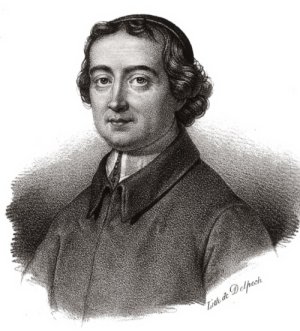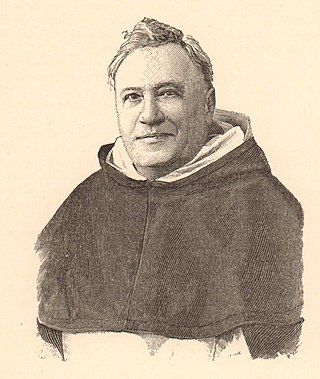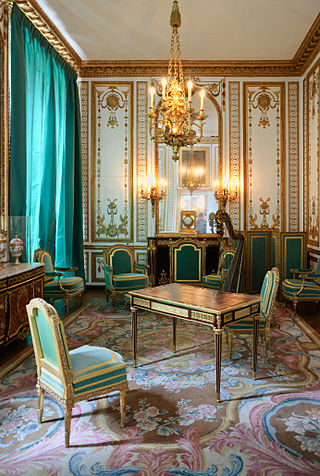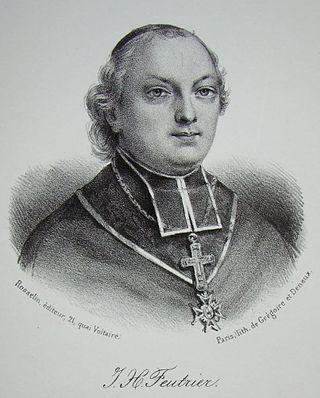
Jacques-Bénigne Lignel Bossuet was a French bishop and theologian renowned for his sermons and other addresses. He has been considered by many to be one of the most brilliant orators of all time and a master French stylist.

Jean-Baptiste Massillon, CO, was a French Catholic prelate and famous preacher who served as Bishop of Clermont from 1717 until his death.

Louis, Duke of Orléans was a member of the House of Bourbon, and as such was a prince du sang. At his father's death, he became the First Prince of the Blood and Duke of Orléans. Known as Louis le Pieux and also as Louis le Génovéfain, Louis was a pious, charitable and cultured prince, who took very little part in the politics of the time.

The Diocese of Beauvais, Noyon, and Senlis is a Latin Church ecclesiastical territory or diocese of the Catholic Church in France. The diocese encompasses the department of Oise in the region of Hauts-de-France. The diocese is a suffragan of the metropolitan Archdiocese of Reims. The current bishop is Jacques Benoit-Gonnin, appointed in 2010.

The former bishopric of Mâcon was located in Burgundy. The bishopric of Macon was established as a suffragan of Lyon. The existence of Mâcon as a separate diocese ended at the French Revolution.

Jean-Baptiste Oudry was a French Rococo painter, engraver, and tapestry designer. He is particularly well known for his naturalistic pictures of animals and his hunt pieces depicting game. His son, Jacques-Charles Oudry, was also a painter.

The Metropolitan Archdiocese of Montpellier (–Lodève–Béziers–Agde–Saint-Pons-de-Thomières) is a Latin archdiocese of the Catholic Church in south-western France. It was probably created in the 3rd century AD. The current metropolitan archbishop is Pierre-Marie Carré; the immediate past Archbishop Emeritus is Guy Marie Alexandre Thomazeau. On September 16, 2002, as part of the reshuffling of the map of the French ecclesiastical provinces, the diocese of Montpellier ceased to be a suffragan of Avignon and was elevated to archdiocese and metropolitan of a new ecclesiastical province, with the dioceses of Carcassonne, Mende, Nimes and Perpignan–Elne as suffragans.

Charles-Auguste-Marie-Joseph, Count of Forbin-Janson, C.P.M., was a French aristocrat and prelate who was a founder of the Fathers of Mercy, established in an effort to re-evangelize the French people. He preached throughout North America, taking an active role in reviving the Catholic populations of the United States and Canada. He was influential in establishing an ultramontane stand in the Catholic Church in French-speaking Canada, an influence which would last for generations.

The former French Catholic diocese of Senez existed from around the fifth or sixth century, until the French Revolution. Its see was at Senez, in southern France, in the modern department of Alpes-de-Haute-Provence. After the Concordat of 1801 the territory of the diocese was added to that of the diocese of Digne.

The Archdiocese of Dijon is a Latin diocese of the Catholic Church in France. The archepiscopal see is Dijon Cathedral, which is located in the city of Dijon. The diocese comprises the entire department of Côte-d'Or, in the Region of Bourgogne. Originally established as the Diocese of Dijon in 1731, and suffragan to the Archdiocese of Lyon, the diocese was elevated to the rank of archdiocese in 2002. The most significant jurisdiction change occurred after the Concordat of 1801, when the diocese annexed the department of Haute-Marne. In 1821, a papal bull re-established the Diocese of Langres. The current archbishop is Antoine Hérouard, appointed in 2022.

Jacques-Marie-Louis Monsabré was a French Dominican, a celebrated pulpit orator.

Louis XVI style, also called Louis Seize, is a style of architecture, furniture, decoration and art which developed in France during the 19-year reign of Louis XVI (1774–1793), just before the French Revolution. It saw the final phase of the Baroque style as well as the birth of French Neoclassicism. The style was a reaction against the elaborate ornament of the preceding Baroque period. It was inspired in part by the discoveries of Ancient Roman paintings, sculpture and architecture in Herculaneum and Pompeii. Its features included the straight column, the simplicity of the post-and-lintel, the architrave of the Greek temple. It also expressed the Rousseau-inspired values of returning to nature and the view of nature as an idealized and wild but still orderly and inherently worthy model for the arts to follow.

Émile Bougaud, born Edme Louis Victor Bougaud was French, known as a writer and preacher. He became Bishop of Laval.
Events from the year 1814 in France.

Michel Poncet de la Rivière was a French clergyman, preacher and, from 1706 to 1730, the 79th bishop of Angers. He was the son of Vincent-Matthias Ponchet de la Riviere, the Lord Lieutenant of Alsace, and his wife, Marie Betauld; the nephew of Michel Poncet de la Rivière, the 61st Bishop of Uzès (1677–1728); the uncle of Mathias Poncet de la Rivière, the 90th Bishop of Troyes (1742–1758); and the cousin of Joseph Poncet de la Rivière, the Jesuit missionary of Canada.
Charles Philippe d’Albert, 4th Duke of Luynes held the title Duke of Luynes from 1712 to 1758. He wrote an important memoir of life at the court of Louis XV.

Jeanne Baptiste d'Albert de Luynes, comtesse de Verrue was a French noblewoman and the mistress of Victor Amadeus II of Sardinia.

François-Jean-Hyacinthe Feutrier was a French Catholic priest who became Bishop of Beauvais. He was Minister of Religious Affairs from 3 March to 8 August 1829. He caused a storm of protest from the other bishops in France when he signed an ordinance aimed at restricting the influence of the church in schools.

Étienne-Antoine Boulogne was a French cleric of the Roman Catholic Church. He served as Bishop of Troyes from 1809 to 1825.
















